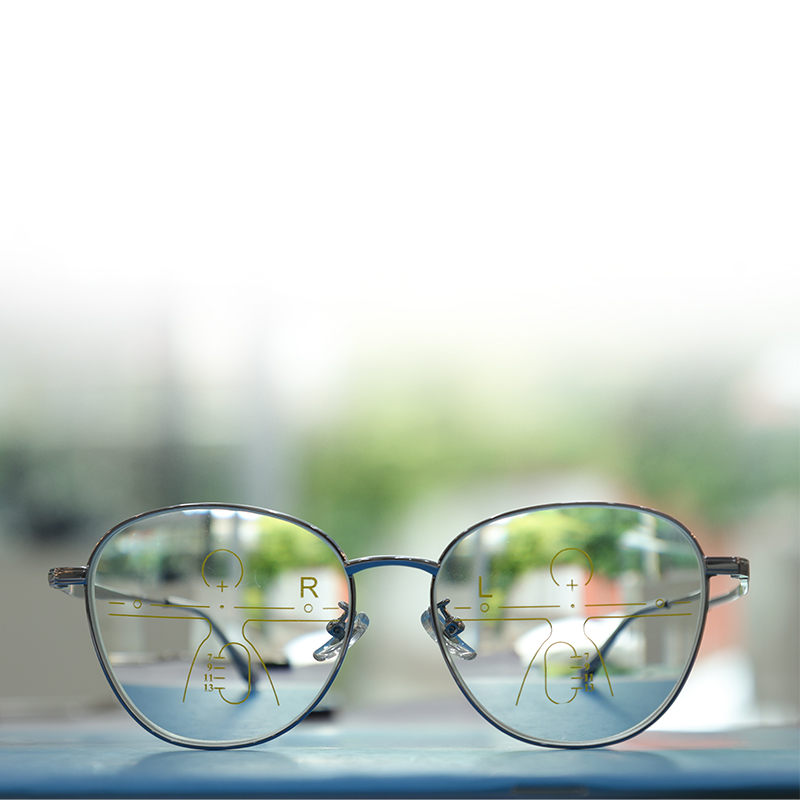
Transitions lenses, also known as photochromic lenses, are eyeglass lenses that automatically adjust their tint based on the amount of UV light exposure. They darken when exposed to sunlight and return to a clear state indoors or in low-light environments.
How They Work:
Photochromic molecules embedded in the lens react to UV light. When exposed to sunlight, these molecules change structure, causing the lenses to darken. Once UV exposure decreases (such as indoors), the molecules return to their original state, and the lenses become clear again.
Key Benefits:
✅ Convenience – No need to switch between prescription glasses and sunglasses.
✅ UV Protection – Blocks 100% of UVA and UVB rays, helping protect your eyes from harmful sun exposure.
✅ Reduced Eye Strain – Helps with glare and light sensitivity, reducing squinting.
✅ Customization – Available in different colors, styles, and coatings, including polarized options for additional glare reduction.

Shaw™ Lenses are specialized prescription lenses designed to correct eye misalignment issues, particularly anisometropia (a significant difference in prescription between the two eyes) These lenses use a unique neuromuscular approach to minimize distortion and discomfort caused by traditional lenses in these conditions.
How Shaw Lenses Work:
Shaw lenses use a technology called "binocular balance" to reduce the difference in image size (aniseikonia) between the two eyes. Unlike standard lenses, which can cause image disparity and discomfort, Shaw lenses are custom-designed to maintain equal image sizes, improving comfort and depth perception.
Key Benefits:
✅ Reduces Image Size Difference – Helps the brain fuse images from both eyes, reducing double vision.
✅ Improves Binocular Vision – Encourages both eyes to work together naturally.
✅ Minimizes Distortion – Reduces visual discomfort and dizziness associated with anisometropia.
✅ Custom Design for Each Patient – Lenses are tailored based on advanced calculations of the patient’s prescription and eye coordination.
Who Can Benefit?
- Patients with anisometropia – Those with a large difference in prescription between their two eyes.
- Post-surgery patients – For those who have undergone eye surgeries (e.g., retinal detachment repair, cataract surgery) and have unequal refractive errors.
- Children with amblyopia ("lazy eye") – Can assist in visual development and rehabilitation.
Shaw lenses are not widely available everywhere and require special fitting by an optometrist trained in their technology.
https://shawlens.com/

Progressive lenses are multifocal eyeglass lenses that provide a seamless transition between multiple vision zones—distance, intermediate, and near—without the visible lines found in bifocals or trifocals. They are commonly used by people with presbyopia, an age-related condition that makes it harder to focus on close objects.
How Progressive Lenses Work:
Progressive lenses have a gradual power transition from top to bottom:
🔹 Top Section – Designed for distance vision (e.g., driving, watching TV).
🔹 Middle Section – Provides intermediate vision (e.g., computer screens, dashboards).
🔹 Bottom Section – Optimized for near vision (e.g., reading, using a phone).
Unlike bifocals or trifocals, which have abrupt power changes (causing an image jump), progressive lenses offer a smooth visual experience.
Benefits of Progressive Lenses:
✅ No Visible Lines – Looks like regular single-vision lenses, making them more aesthetically pleasing.
✅ Smooth Transition – No "image jump" when switching between distances.
✅ All-in-One Solution – Eliminates the need to switch between multiple pairs of glasses.
Who Should Get Progressive Lenses?
✔ People over 40 years old with presbyopia.
✔ Those who want one pair of glasses for all distances.
✔ Anyone looking for a modern alternative to bifocals or trifocals.
Anti-reflective Treatments
Anti-reflective (AR) coating, also known as anti-glare coating, is a thin multi-layer coating applied to eyeglass lenses to reduce reflections, glare, and halos. It enhances vision clarity, improves aesthetics by making the lenses nearly invisible, and reduces eye strain—especially in bright or low-light conditions.
Key Benefits of AR Coating
✅ Improved Vision Clarity – Reduces glare from lights, screens, and headlights.
✅ Better Aesthetics – Eliminates lens reflections, making your eyes more visible in photos and videos.
✅ Reduced Eye Strain – Helps during prolonged screen time or night driving.
✅ Enhanced Durability – Many AR coatings include scratch resistance, UV protection, and water-repellent properties.
Best Situations for AR Coating
🔹 Computer & Screen Use – Minimizes digital eye strain from blue light and reflections.
🔹 Night Driving – Reduces glare from oncoming headlights and streetlights.
🔹 High-Prescription Lenses – Prevents thick lenses from looking overly reflective.
🔹 Photography & Video Calls – Eliminates distracting reflections on camera.

Custom tint lenses are eyeglass or sunglass lenses that have been dyed or coated with a specific color to enhance vision, reduce glare, or make a fashion statement. They can be tailored to different shades, opacities, and functionalities based on your needs.
Types of Custom Tint Lenses
🔹 Solid Tint – A uniform color throughout the lens, commonly used for sunglasses or fashion eyewear.
🔹 Gradient Tint – Darker at the top and gradually fades towards the bottom, reducing glare while keeping the lower vision clear.
🔹 Double Gradient Tint – Dark at the top and bottom but lighter in the middle, ideal for outdoor and water activities.
🔹 Mirror Tint – Reflective coating on the outer lens surface, reducing brightness and adding a stylish look.
Benefits of Custom Tint Lenses
✅ Glare Reduction – Helps with outdoor activities and bright environments.
✅ Enhanced Contrast – Specific tints improve color perception and depth.
✅ Eye Protection – Can block harmful UV rays when combined with UV coatings.
✅ Aesthetic Appeal – Offers a stylish, customized look

Chem Clip’s are a type of clip-on lenses designed by Chemistrie Eyewear. These are high-quality, custom-made magnetic clip-on lenses that attach seamlessly to prescription glasses. Unlike traditional bulky clip-ons, Chem Clips are ultra-thin, lightweight, and use small magnets embedded in the lenses for a nearly invisible connection.
Features of Chem Clips:
✅ Custom Fit – Designed to match the exact shape of your eyeglass lenses.
✅ Magnetic Attachment – Uses small, embedded magnets for a secure and seamless fit.
✅ Lightweight & Thin – Unlike traditional clip-ons, Chem Clips are sleek and barely noticeable.
✅ Multiple Lens Options – Available as sunglasses, blue light filters, or 3D lenses.
✅ Variety of Tints – Choose from solid, gradient, or polarized lenses to suit your needs.
Types of Chem Clips:
1️⃣ Sun Clips – Polarized or tinted lenses for UV protection and glare reduction.
2️⃣ Blue Light Clips – Filters harmful blue light from digital screens.
3️⃣ Readers Clips – Provides magnification for reading without switching glasses.
Why Choose Chem Clips?
🔹 Convenience – No need to switch between multiple glasses.
🔹 Aesthetically Pleasing – Designed to look like part of your original glasses.
🔹 Durable & High-Quality – Made from lightweight yet sturdy materials.
🔹 Wide Compatibility – Can be customized for almost any frame shape.

When choosing eyeglass lenses, the material plays a crucial role in durability, thickness, weight, and optical clarity. Below is a breakdown of the most common lens materials and their advantages.
1️⃣ CR-39 Plastic (Standard Plastic Lenses)
🔹 Index: 1.50
🔹 Pros: Affordable, lightweight, good optical clarity
🔹 Best for: Basic prescription glasses with mild corrections
2️⃣ Polycarbonate Lenses
🔹 Index: 1.59
🔹 Pros: Lightweight, impact-resistant, built-in UV protection
🔹 Best for: Active individuals, kids, safety glasses, and rimless frames
3️⃣ Trivex Lenses
🔹 Index: 1.53
🔹 Pros: Superior optical clarity compared to polycarbonate, lightweight, impact-resistant, built-in UV protection
🔹 Best for: Those wanting a balance of clarity, durability, and lightness
4️⃣ High-Index Plastic Lenses (Thin Lenses)
🔹 Index: 1.60, 1.67, 1.74
🔹 Pros: Thinner and lighter than CR-39 and polycarbonate, great for high prescriptions, better aesthetics
🔹 Best for: People with strong prescriptions who want thinner, more stylish lenses
High-Index Material | Thickness Reduction | Best for Prescription
1.60 Index | ~25% thinner | Moderate prescriptions (-4.00 to +4.00)
1.67 Index | ~30% thinner | Higher prescriptions (-6.00 to +6.00)
1.74 Index | ~35% thinner | Very high prescriptions (-8.00 and beyond)
Choosing the Right Lens Material for You
✔ For Safety & Durability → Polycarbonate or Trivex
✔ For Thin, Aesthetic Lenses → High-Index (1.67 or 1.74)

Anti-fatigue lenses are designed to help reduce eye strain caused by prolonged near work, such as reading, computer use, and smartphone usage. These lenses have a mild boost in power at the bottom of the lens to help relax the eye muscles, making it easier to shift focus between distances.
How Anti-Fatigue Lenses Work
🔹 Distance Vision (Top of the Lens) – Functions like a standard single-vision lens for clear distance vision.
🔹 Near Boost (Bottom of the Lens) – Provides a slight magnification (usually +0.40D to +0.75D) to ease eye strain when focusing on close objects.
This subtle power boost helps reduce the constant effort required by the ciliary muscles (the eye’s focusing muscles), preventing fatigue and discomfort.
Benefits of Anti-Fatigue Lenses
✅ Reduces Digital Eye Strain – Eases the transition between screens and real-world vision.
✅ Less Eye Fatigue & Headaches – Prevents overuse of eye muscles, reducing discomfort.
✅ Smooth Adaptation – No distortion like traditional progressive or bifocal lenses.
✅ Good for Pre-Presbyopia – Helps younger adults (20s–40s) experiencing early near-vision strain.
Who Should Use Anti-Fatigue Lenses?
✔ Students & Office Workers – Those who spend long hours reading or using digital screens.
✔ People with Eye Strain Symptoms – Including tired eyes, headaches, or difficulty focusing.
✔ Individuals with Early Presbyopia

Computer lenses (also known as computer glasses or digital lenses) are specially designed to reduce eye strain, glare, and blue light exposure from screens. They optimize vision for intermediate distances (about 20–26 inches away), which is the typical distance for computer screens.
How Computer Lenses Work
🔹 Optimized for Mid-Range Vision – Unlike regular reading glasses, computer lenses enhance focus at the intermediate distance where screens are typically placed.
🔹 Blue Light Filtering – Many computer lenses include coatings that reduce exposure to harmful blue light, which can contribute to digital eye strain and sleep disturbances.
🔹 Anti-Reflective (AR) Coating – Helps reduce glare from overhead lights and screen reflections for better contrast and clarity.
🔹 Slight Magnification (Optional) – Some computer lenses include a mild boost in power (+0.40D to +1.25D) to reduce eye strain from prolonged screen use.
Benefits of Computer Lenses
✅ Reduces Digital Eye Strain (DES) – Helps prevent headaches, dry eyes, and fatigue from long screen time.
✅ Improves Contrast & Clarity – Anti-reflective and blue light coatings enhance screen visibility.
✅ Minimizes Glare – Reduces reflections from artificial lighting and digital screens.
✅ Encourages Better Posture – Eliminates the need to lean forward or tilt the head to see clearly, preventing neck and back pain.
Types of Computer Lenses
1️⃣ Single-Vision Computer Lenses – Designed solely for intermediate screen distance. Best for younger individuals without presbyopia.
2️⃣ Office/Occupational Progressives – Multifocal lenses optimized for near and intermediate vision, ideal for professionals who need to switch between screens and desk work.
Who Should Use Computer Lenses?
✔ Office Workers & Gamers – Anyone spending 6+ hours on screens daily.
✔ Students & Remote Workers – Those who read or type for extended periods.
✔ People with Digital Eye Strain Symptoms – If you experience dry eyes, headaches, blurry vision, or fatigue from screen use.
✔ Individuals with Presbyopia – If you’re 40+ and struggle with near and mid-range vision.



